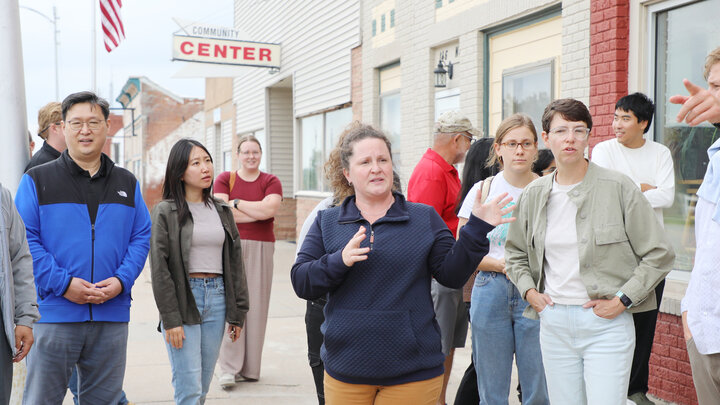At least three Huskers played a role in Super Bowl LIII in Atlanta; most memorably, Rex Burkhead, whose overtime touchdown run in the AFC Championship game sealed the New England Patriots’ berth in the Super Bowl held at the new Mercedes-Benz Stadium.
But a less prominent Husker was partially responsible for the Mercedes-Benz Stadium itself being there at all. Erleen Hatfield, a 1991 and 1996 graduate of Nebraska’s architecture and engineering schools, was the structural engineer of record for the $1.6 billion stadium.
That means Hatfield was ultimately responsible for every mathematical calculation that went into making sure the 2-million-square-foot stadium would stand flush and plumb, that its 728-foot roof trusses would bear the load of a 2,000-ton scoreboard hung from the roof and that the structure, which includes a 16-story window, would withstand any amount of wind and rain — plus the mini earthquakes generated by up to 75,000 rabid fans.
But the first order of business for Hatfield was proving the feasibility of the proposed stadium’s 14.5-acre roof, with eight panels that needed to open like the aperture of a camera. Dozens of publications and more than one television documentary have tabbed it the “world’s most ambitious retractable roof.”
Before presenting the proposed design to the Atlanta Falcons owner, the lead design architect, Bill Johnson of St. Louis-based HOK, had a moment of doubt and called Hatfield for reassurance. “Everybody loved the design and were like, ‘This is what we want to do,’ but (Johnson) called me and said, ‘This is crazy, do you actually think you can make it work?’ ” Hatfield recalls.
She took out a napkin. “I ran some numbers and did some calculations by hand, to understand first principles and the physics of it. I knew we could make it play out,” she says.
Computer analyses later proved her handwritten calculations correct which, as it turns out, is not an uncommon feat for Hatfield, at least according to James Brakenhoff (’21) a Nebraska graduate who started at Hatfield’s firm as an intern before being hired full-time. While Brakenhoff was helping design the steel beams and columns for a Best Buy renovation, Hatfield told him offhand how much load would be on each and her guesstimated size for the pieces of steel.
“I then spent a week doing the calculations and her ‘guesses’ were spot-on,” Brakenhoff says. “I don’t know that it was really a guess — I think she might have just known.”
A graduate of Lincoln Southeast High School, Hatfield had been mechanically and mathematically inclined since her early childhood. She recalls a house littered with her cardboard edifices and her brother, Scott Hatfield (’93), remembers a Christmas when his 7-year-old sister independently put together a mechanized 1,000-piece model car engine.
“She put it together and then had advanced auto-engine discussions with my dad for months, before moving on to the intricacies of nuclear power,” Scott says. “I’m not kidding. She seriously wanted to build a small nuclear reactor for our own power use until my dad explained to her the nitty gritty of uranium.”
Hatfield disputes that she had nuclear ambitions; regardless, the child moved on to teaching herself to code in Fortran. Scott, a real estate investor who also owns Duffy’s Tavern, said his own parlor tricks at the time consisted of “doing like six things with a slinky.” (Granted, he was 5.)
Erleen Hatfield spent her first year of college as a golfer (major undeclared) at Nebraska Wesleyan but transferred to the University of Nebraska as a sophomore to major in architecture.
She was also precocious on the golf course, and her experience there may have helped her develop the intestinal fortitude she would need to work in an industry dominated almost completely by men. (Less than 15% of U.S. structural engineers are female, and she recalls being the only woman in more than one of her master’s level engineering classes.)
But, Scott says, “Erleen was never afraid of barriers, and my parents encouraged that.”
Acknowledging her golf skills, her dad encouraged her to play from the men’s tees. When the Hatfield siblings were 15 and 13, Scott says, they were playing a golf course in Ohio and the course marshal started shouting at Erleen to get off the men’s tees while her dad told her to ignore him.
“With this random guy yelling at her, she just put the ball in the ground, set up and smashed it down the middle of the fairway. She picked up her tee and we left. The course guy sped away humiliated,” Scott says. “The point is, she was encouraged to do whatever she thought she could excel at, and she’s nails under pressure.”
After completing her master’s in civil engineering at Nebraska, Erleen headed to Chicago to work on bigger buildings at Thornton Tomasetti. That firm transferred her to New York City to work on a stadium for the Detroit Lions for a year.
She was captivated by the length of the 630-foot-long trusses. “It’s a very specialized field; you need people who understand the complexity of long-span engineering and construction,” Hatfield says. “All of (the firm’s) expertise in that was in New York City. I came for a year and I never left. I’ve done all kinds of things — a lot of museums and cultural institutions — but I’ve always had a sports project since I started working on the Lions.”
The sports specialty has also afforded her the opportunity to leave her mark on her alma mater. She was the structural engineer of record on Nebraska basketball’s Pinnacle Bank Arena and is currently the lead on Nebraska’s new football training facility.
As one who came of age during the Husker football reign of dominance, Hatfield says she is thrilled to have an opportunity to contribute to a facility that may help future Husker teams regain an edge.
After finishing up her work on the Mercedes-Benz stadium, Hatfield left her firm, Buro Happold, and started The Hatfield Group in 2018 in order to focus more on what matters to her: the primacy of design and treating employees with respect. Between running the business, crunching numbers and teaching at Yale University’s school of architecture, she says she probably works 60 hours each week — which doesn’t leave much time for golf.
That’s OK with her. “I’m passionate about what I do,” Hatfield says. “I love structural engineering and I love seeing buildings built.”
Nebraska Quarterly article by Melissa Castro Wyatt




